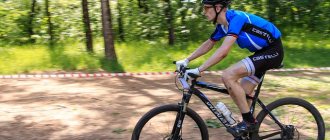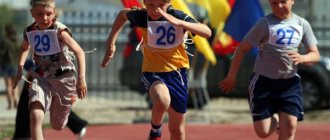Running on rough terrain is considered more natural for the human body than running on paved roads. During such a run, you have to overcome many obstacles - bumps, stones, sharp turns, ravines, climbs and other uneven terrain. Cross running is much more difficult than usual, but it is much more varied, and therefore the body does not have time to get used to the load and is constantly training.
What is trail running
Trail running or simply cross-country running is a subtype of cross-country running that is performed in unprepared territory with variable terrain and natural obstacles. The concept includes almost all types of terrain, except asphalt and prepared stadiums. Trail running is the most practical and challenging type of running that requires a certain level of physical fitness. The main types of terrain are:
- Mountains;
- Any wilderness;
- Descents;
- Woodland;
- Gorges;
- Hills.
Even shallow rivers that can be crossed (depending on the time of year) become an obstacle for the trail runner. Each race is a test of your capabilities, which improves your physical fitness to overcome more difficult distances.
Relief elements
Rough terrain is unevenness that determines the type and nature of the earth's surface. They are usually divided into landforms. A mountain is a dome-shaped or conical hill. The upper part can be sharp (peak) or flat (plateau). The base of the mountain is called the base, and the side faces are called the slopes. If the height of the formation is up to 200 m, then it is usually called a hill. If it is of artificial origin, then it is a mound. Several hills located in the same direction form a ridge.
A depression of terrain with a closed cup-shaped depression is called a basin. If it is small, then it is a hole. A hollow is usually called a pronounced depression in the terrain in one direction with a clearly noticeable depression. If such a formation has steep edges and steep slopes, then it is called a ravine. Between two adjacent peaks of the ridge, as a rule, there is a depression. This formation is called a saddle.
Pros and cons of trail running
The main advantages of trail running:
- Marked increase in physical fitness (superior to almost all types of running in effect);
- Increased endurance and explosive speed and strength indicators;
- Increased coordination;
- Involves all muscle groups;
- Ability to quickly make decisions, depending on the situation;
- An exciting and fun sport;
- Improves wilderness survival skills.
Despite the impressive list of advantages, this type of running also has a number of disadvantages :
- Requires preliminary physical training (mastering different running techniques, training muscles in the gym, performing other specialized exercises);
- Requires a special form. Regular clothes are not suitable. Everything from a backpack to socks and trail running shoes is selected taking into account the specialization of running;
- Increased injury rate compared to other types of running.
DVR.
Take a DVR or GoPro camera with you on the road. After all, having seen many interesting places, you will probably want to share with someone the experience of your trip and remember it again. Also, the DVR itself can be useful to you in the event of an accident. With the help of the recording, you can prove that you are not at fault for the accident.
Who is this run suitable for?
This is a competitive type of running, so it is suitable for both those who like to compete with other athletes and those who prefer to challenge themselves and their abilities. Cross-country running is a sport that is included in the “Ready for Labor and Defense” complex.
According to the GTO standards, cross-country running is carried out at the following distances:
- 1 km;
- 2 km;
- 3 km;
- 5 km.
In general, trail running is suitable for anyone who wants to experience intense emotions from sports, gain powerful physical training, and even become an expert in moving through the most impassable terrain.
How to start running cross-country?
Beginner runners need to know the rules that will allow them to achieve high results through training. In this type of running, the load should be increased gradually. But first, it’s generally better to walk at a pace and study the intended route.
During the first two to three months, it is recommended to choose an easy route, without steep ascents and descents, and increase the difficulty of the distance as you train. Cross-country is good to run along a forest path, or a flat area where there are small hills and descents.
When you get used to the loads and your muscle tone increases, you can begin training on a more difficult route.
A few words about jogging time. If it is enough for beginners to spend twenty minutes on cross-country, then as training progresses this time can be gradually increased, up to an hour and a half. You need to run cross-country at least twice a week. Only in this case will this training benefit you.
Cross-country running technique
Running techniques are radically different from regular jogging. Moreover, cross-country running shoes differ in technology from regular shoes, so they will not allow you to use conventional techniques.
In terms of technique and preparation, there are several mandatory elements of trail running that should be mastered:
- Running uphill is a skill required for this sport. When lifting, you need to slightly round your shoulders and tilt your body forward (to maintain balance). Elbows point to the sides. It is also necessary to keep your knees bent and move your pelvis slightly forward.
- Running down is the easiest element. If trail running shoes are properly fitted to minimize slipping, these are areas where athletes will typically “rest.” The key to running downhill is to have a relaxed body (especially in the legs and pelvis) and a heel strike. A slight tilt of the body forward is allowed.
- The rock and rock running technique is the most difficult cross-country running technique. Requires long training, the ability to maintain balance and belay with your hands. Landing is performed on the entire surface of the foot or on the toe (depending on the terrain);
- Breathing – Paying attention to proper breathing is much more important in trail running than in regular running. This is facilitated by constant changes in altitude, load and intensity. Standard recommendations include breathing in through the mouth and exhaling through the nose, but if there is a lack of oxygen, inhaling and exhaling through the mouth is allowed. A temporary transition to brisk walking is also used to normalize breathing.
An important element is strength training. To improve physical abilities, the following types of exercises are used:
- Lunges (all types, including lunges on inclined terrain up and down);
- Squats with weight;
- Swing your legs forward, backward and to the sides;
- Running uphill on steps or on a track;
- Jumping boards (short and high jumps) and other plyometric movements;
- Short series of sprints on flat and sloping terrain.
Additional back and core exercises may also be required to ensure full core stabilization and reduce compression on the spine.
Paper map.
If you, friends, are relying on a card that is installed on your smartphone or tablet, then you are in vain. Remember that any electronic equipment can fail at the most inopportune moment for you. It’s better to take with you a regular paper map with which you can always find the right road if you suddenly get lost. In combination with a regular compass, a paper map will allow you to quickly find the right road.
Choosing clothes and shoes for trail running: how to dress
Trail running requires special equipment. The main elements include:
- Trail running shoes;
- Fitness watch with GPS tracker;
- Trekking poles - only for long runs over very difficult distances;
- Socks or gaiters for trail running - legs and arms should be completely covered to prevent branches or other vegetation from causing damage to the skin;
- Backpack.
Athletes also wear gloves, knee pads, a hat and glasses to protect from the sun (and mechanical damage from branches), a T-shirt or long-sleeve sweater made of breathable synthetics.
Top 3 Best Trail Running Shoes
When choosing shoes, consider the following features:
- Weather and time of year (for example, for wet areas or running in winter, shoes on top should be protected by a membrane);
- Tread – if the ground is hard, choose a low tread. For unstable terrain (rocks, slopes, snow, etc.) it is better to take an aggressive tread.
Today, almost all top manufacturers produce specialized shoes for this sport. Some of the best running shoes for trail running include:
- Model Terrex Skychaser GTX from Adidas;
- Speedcross 4 by Salomon;
- GEL-FujiTrabuco 7 from Asics.
In general, there are many models, so the main thing is that they meet all the standards of a particular type of running.
Which backpack is better to choose?
The first rule of a runner who decides to conquer unprepared routes is that an ordinary backpack is not suitable for this sport. A backpack for trail running should have a design that has the following features:
- Tight fixation to the body and no “looseness”;
- Breathable fabric;
- Lots of pockets;
- Additional fixation (usually in the chest area).
A backpack for such sports is more like a tight-fitting vest than the classic urban or hiking options.
Cloth
Almost all clothing for this style of running is specialized. There are no special requirements for selection, although it is important to consider the following rules when choosing:
- Lightweight and elastic material for T-shirts and sweatshirts that does not restrict movement. A hood is also required;
- No cotton (it quickly absorbs sweat and impairs movement), only high-quality breathable synthetics;
- Gaiters with a water-repellent sock (usually combined models made of synthetic and woolen threads are selected);
- Synthetic pants or shorts that do not restrict movement (shorts are selected so that, together with leggings, they completely cover the leg);
- Soft underwear to prevent irritation and chafing.
Take some spare car parts with you on the road.
Each and every car has specific spare parts, which often fail and which are practically impossible to find in stock in auto stores. We advise you, friends, to take with you on a long trip some necessary consumable spare parts from your own car. Also, do not forget to take with you a tool with which you can easily and independently troubleshoot a malfunction on the road or replace a broken spare part with a new one. For example, we advise you to take a fuel pump with you, which you can change yourself if it breaks down.
Cross-country running: GTO rules
- According to the table of GTO rules for cross-country running for children and women and men of any age, time indicators are not taken into account. The main thing is going the distance.
- For men and women aged 60-69, only total distance is taken into account. The norm for rough terrain is 3 km (regardless of pace, speed and other conditions).
- For people aged 70 years and above, the distance norm is reduced to 2 km.
| GTO standards for cross-country running | ||||
| Age | Men | Women | ||
| Mileage | Time | Mileage | Time | |
| 9-10 years | 2 km | No time tracking | 2 km | No time tracking |
| 11-12 years old | 3 km | No time tracking | 3 km | No time tracking |
| 13-15 years old | 3 km | No time tracking | 3 km | No time tracking |
| 16-39 years old | 5 km | No time tracking | 3 km | No time tracking |
| 40-59 years old | 3 km | No time tracking | 2 km | No time tracking |
Source of data in the table: https://gto-normativy.ru/normy-gto-beg/
Take a set of tools.
You guys don’t want to vote and ask for help in the middle of the highway and even at night, do you? Then don’t forget to take a set of car keys with you on your trip, which will help you, if necessary, repair your car if an unexpected breakdown occurs along the way.
Check all vehicle fluids before driving.
Before you hit the road, check the following fluids in your car in advance: -engine oil, antifreeze level, brake fluid level, power steering fluid, gearbox oil. Also, don’t forget to check the freon in your car’s air conditioner.
History of origin
Our primitive ancestors had to cross natural terrain for the first time, chasing prey and running away from predators.
In the 11th century, the race was already a competition. The kings chose their best messengers, determining who would get to the mountain top the fastest. The first such race took place in 1065 in Great Britain, the length of the route was 537 meters.
This is how it was not trail running itself that was formed, but its predecessor, fell running.
Then guides racing arose. They were attended by local residents of England who knew the area well and therefore worked with visiting tourists. Hence the specific name.
Trail running officially appeared only in 1995, when it was recognized by the British Academy of Athletics.
The International Trail Running Association (ITRA) is an international governing body for trail running that was formed in 2013.
The International Association of Athletics Federations (IAAF) officially incorporated the sport into athletics in 2015.
Download training plans to prepare for the marathon and half marathon.
Start preparing right now!
Since then, more and more professional athletes and amateurs find themselves in this type of race.
What is the highlight of trail running?











